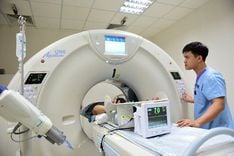This is an automatically translated article.
Treatment of brain metastatic cancer by brain radiosurgery (STEREOTACTIC RADIOSURGERY - SRS) is the most modern brain radiotherapy technique in Southeast Asia today. This technique has only been applied at the world's leading radiation therapy centers for about 10 years now.
1.What is SRS brain radiosurgery? Scientific name: SRS brain radiosurgery Common name: Treatment of brain metastatic cancer by SRS brain radiosurgery Technical description SRS brain radiosurgery is a method that uses multiple beams of radiation that are not too strong. The radiation receivers concentrated in the brain tumor will receive a very large dose of radiation to kill the cancer cells. SRS brain radiosurgery is usually done in one treatment, and doctors can destroy multiple tumors in one treatment. Most cases can go home the same day. The risk of long-term cognitive decline after SRS treatment is believed to be less than with whole brain radiation, increasing the patient's chances of survival, cognitive ability, and quality of life.
2.What disease is this technique used for? Brain cancer 3.Indications and contraindications Indications:
Patients with brain metastases with less than 4 metastases. Contraindications:
Patients with extensive brain metastases of more than 5 foci should consider whole brain radiation therapy.

Điều trị ung thư di căn não bằng phương pháp xạ phẫu não là kỹ thuật xạ trị não hiện đại nhất Đông Nam Á hiện nay.
4.Advantages and disadvantages of the technique Advantages:
OSMS system observes head movements accurately to each mm, No need to drill the skull to fix the head like Gamma Knife radiation in other units. The Hyper-Arc non-planar brain radiosurgery system was first used in Southeast Asia to help control the high dose of radiation to the tumor, distribute the dose to the tumor uniformly and minimize the radiation dose on the brain organ. so there are very few side effects. The Encompass dedicated head immobilization system of Qfix (USA) is also specially designed to be used specifically for this SRS radiation system, ensuring the most accurate fixation of the patient's head while maintaining the comfortable and gentle during radiotherapy. Cons:
Longer planning time than conventional techniques High and complicated techniques 5. Implementation process Step 1: Simulate SRS radiation therapy Step 2: Plan SRS radiation therapy Step 3: Evaluation Treatment plan Step 4: SRS radiotherapy 6. Normal symptoms after the procedure Fatigue Poor diet Mild dermatitis Headache 7.When are the following symptoms after the procedure are abnormal and need to be repeated check right away? High fever Difficulty breathing 8. Things to keep in mind when performing this technique The best treatment for a patient with brain metastatic cancer will depend on the size, number, and location of the tumor, as well as other medical conditions. signs and symptoms, general health and wishes of the patient.
Please dial HOTLINE for more information or register for an appointment HERE. Download MyVinmec app to make appointments faster and to manage your bookings easily.













